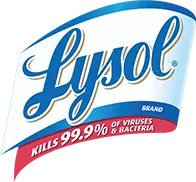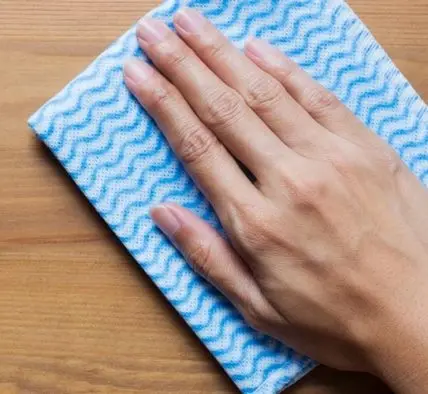*NOTE: It is recommended that prior to using this lesson, you introduce the topics of germs on hands and surfaces via the Healthy Habits lesson: Surface Smarts.
Prevent Germs From Spreading
Teach About Germs Lesson Plan for Kids
Students will take their knowledge* and share it with their school community through a public awareness campaign, thus promoting preventative actions that can help others stay healthy.

Goals and Skills
STUDENTS WILL:
- Review and explain how germs can be transferred from hands to surfaces and back to hands
- Collect, represent, and interpret data about potential germ “hotspots” around the school
- Create public awareness messages to share what they have learned with their school community and families to promote healthy habits
SUPPLIES AND PREPARATION:
- Chart paper
- Art supplies (poster paper, color markers, crayons, markers, color pencils, glue sticks, tape, scissors)
- Download and print LYSOL®’s handwashing poster
- Optional: radio (or MP3 player/computer with speakers); musical instruments (e.g., xylophone, triangle, and/or keyboard)
*If you do not have access to a computer lab or computers/tablets with an internet connection for students, gather facts on handwashing, germs, and disease prevention from the Background for Teacher resources prior to conducting this lesson.
BACKGROUND FOR TEACHER:
- Visit the CDC’s general handwashing information here: https://www.cdc.gov/handwashing/
- You can also access the CDC’s germ stats and scientific information (which you can provide to students to use in the Healthy Community Campaign step below) here: https://www.cdc.gov/handwashing/show-me-the-science.html
TEACHER TIP:
Depending on the level of your students and their skills at role-playing, you may either write the scenarios on slips of paper to keep the scenario options “secret,” or you can write them all on the board so that teams can see the potential scenarios being “acted out.”
Instruction Steps
1. GERM TRACKER SCENARIOS.
Review what students already know about germs, preventative healthy practices such as handwashing, and how to prevent the spread of germs at school (covered in the lesson Surface Smarts) by playing a fun game of charades.
HOW TO PLAY:
Divide the class up into groups of four or five students; together, students will compete in teams. Teams will work together to “act out” a given scenario, as non-competing teams guess the scenario while keeping track of the potential germ exposures. Whoever guesses correctly receives a point for their team. At the end of each round, before letting a new team compete, review the key facts for each scenario.
Use the scenarios below to start, but feel free to add your own! Scenarios can involve both germy situations and healthy and preventative actions. After each team has “acted out” its scenario, allow time for recap/discussion.
CHARADE: GERMS GROW AND DIVIDE.
Review the Facts: Some germs can grow and divide every 20 minutes. That means that one single bacteria cell can become more than eight million cells in less than 24 hours! • Charade: Germs pass from a sneeze, to a hand, to a door knob, to another friend. - Review the Facts: This “pass along” scenario is an example of how “cross-contamination” works —without proper handwashing and hygiene practices (such as sneezing into a tissue or the crook of your elbow), germs from a sneeze can contaminate a surface (such as the door knob, in this example) and pass to/infect another person.
CHARADE: GERMS LIVE ON A SURFACE FOR HOURS.
Review the Facts: Studies have shown that some germs can live on surfaces for 20 minutes, and sometimes for hours. That’s why routine surface cleaning and disinfection is so important.
CHARADE: GERMS CAN BE PASSED FROM ONE PERSON TO MANY SURFACES THROUGHOUT THE CLASSROOM…AND THROUGHOUT THE SCHOOL COMMUNITY.
Review the Facts: The Centers for Disease Control and Prevention (CDC) reminds us that germs from unwashed hands can be transferred to other objects, like handrails, table tops, or toys, and then transferred to another person’s hands. It’s a fact that removing germs through handwashing helps prevent the stomach flu and respiratory infections, and may even help prevent skin and eye infections.
2. GERM DATA.
Using the scenarios as a springboard, have students recap the number of potential “germ contact points” in their classroom and in other areas of the school, such as lockers, bathrooms, and cafeteria tables. Have them estimate the number of possible exposures for each—using calculations like the following examples (based upon 28 students in a typical classroom):
- In the classroom, 28 people might touch the doorknob x times per day
- In the hallway, 28 people x # of classrooms in the hall might touch the water fountain handle at least once per day
- In the cafeteria, 28 people x # of classrooms in the whole school might touch the rack of trays each day
Have students work in groups to plot the estimated data for each potential “germ contact point” within the school in a bar or line graph to show which area has the most activity. Students can transfer their graphs to larger chart paper and use colors to display their data using units of measurement and labeling the x and y axes. After completing their graphs, have them display, discuss and interpret them together as a class. Ask: what does the data show? As they consider the classroom versus the entire school, they’ll begin to see the exponential opportunities for an extended pass-along of germs.
TEACHER TIP:
If you have already conducted the extension activity from the Surface Smarts lesson, and gathered this type of data, skip ahead to step #3.

3. HEALTHY COMMUNITY CAMPAIGN.
Using the facts reviewed in the introductory activity and the data gathered in step #2, students will create a healthy public awareness campaign. Create two stations: one station with poster boards and art supplies; the second with writing utensils and notepaper. Provide a radio (or MP3 player/computer with speakers) if possible. If you have access to a few musical instruments (like a xylophone, triangle, or a keyboard), provide those as well.
Explain to students that they will use what they know about germs, about how they can spread via people and surfaces, and the preventative steps people can take to stay healthy. They will share this information with the school community in a couple of ways: visual posters and musical jingles. Allow students to choose which they would rather do.
A. VISUAL POSTERS
Students will use art supplies to create colorful posters to display around the school with the following information:
- Facts about how germs spread
- Step-by-step demonstration of proper handwashing
- Reminders of what surfaces to routinely clean and disinfect
- Healthy actions people can take to prevent the spread of germs
Encourage them to use facts, bold colors, images, and clear actions that people can follow. Remind them to think about where they want to display posters. Ask: what “germ hotspots” would be good locations for signs and reminders?
Provide examples of posters for them to reference, including LYSOL ® ’s handwashing poster
(link to How To Hand Wash PDF)
B. MUSICAL JINGLES
Students will use their craft of words to create catchy musical jingles (raps and poetry work too!) to share healthy messages. Have students begin by brainstorming adjectives and verbs related to healthy habits, handwashing, cleaning surfaces, preventing the spread of germs, etc. Encourage them to think about words that rhyme, as these will help them in the next step. They could also create simple haikus.
After they have collected a variety of vocabulary words to work with, have them craft a message. It should be short and catchy to capture the attention of the audience.
For example:
You’re my friend and it’s nice to share
But germs can live most anywhere!
So when you sneeze, don’t use your hand...
‘Cause you’re contagious. Understand?!
If available, let them use musical instruments to create a simple jingle, or have them set their “healthy announcement” to a song melody they already know.
4. SHARE AND SPREAD.
Have students share their posters and perform their jingles/poetry/raps with the rest of the class. Ask each student to provide two comments for another student that include a compliment and a constructive idea for improvement using an index card for each.
- I really liked______________________ because ___________________________ .
- An idea to improve your ___________________ would be to _________________.
Based on feedback, let students revisit and modify their posters and jingles. Then provide enough time for students to hang their posters around the school.
Students who created the “jingles” will perform or announce one each day over the PA system to share with the rest of the school.
5. REFLECT
As a reflection, have students share what they found to be the most interesting or surprising fact about germs, how they can spread via hands and surfaces, and how to prevent their spread.
6. EXTEND THE LESSON.
- Have students measure the impact of their public awareness campaigns by interviewing and/or taking a survey of peers, teachers, and administrators. Ask students to brainstorm what they would like to learn. They may want to find out if people are washing their hands more frequently than before, or if they learned something from the posters or PA announcements.
- Students can write a script and produce a puppet show for younger kids to communicate about preventing the spread of germs and promoting healthy habits that focus on proper handwashing and clean surfaces.
7. HOME CONNECTION.
Share what you and your students have covered in class with parents in your monthly newsletter, communications, or class blog. Include photos of posters and recordings of student jingles, and/or present them on parent night.
Download the Share Facts, Not Germs! Lesson Plan
Download the Share Facts, Not Germs! Lesson Plan
DISCLAIMER:
Healthy Habits® is Presented by Lysol® in collaboration with NEA and National PTA
SOURCES:
Education Standards: (NHES) Health: 1.5.1, 1.5.3, 2.5.3, 2.5.4, 3.5.2, 4.5.1, 5.5.6, 8.5.1, 8.5.2; (CCSS) English Language Arts: RI.4.2, RI.4-5.3, RI.4.7, RF.4-5.4, W.4-5.2, SL.4-5.1, SL.4-5.4, SL.4-5.5, L.4-5.3; (CCSS) Mathematics: 4.OA.A.2, 4.MD.B.4, 5.MD.B.2
CDC – Be A Germ Stopper Poster https://www.cdc.gov/handwashing/pdf/294906-handwashing-superhero-boy-p.pdf
https://www.cdc.gov/handwashing/pdf/294906-handwashing-superhero-girl-p.pdf
CDC - BAM! Body and Mind https://www.cdc.gov/healthyschools/bam/teachers.htm
CDC – Healthy Schools Parent Engagement Materials https://www.cdc.gov/healthyschools/parentsforhealthyschools/p4hs.htm
CDC - Handwashing Posters https://www.cdc.gov/handwashing/posters.html
CDC- Handwashing Stickers https://www.cdc.gov/handwashing/stickers.html




